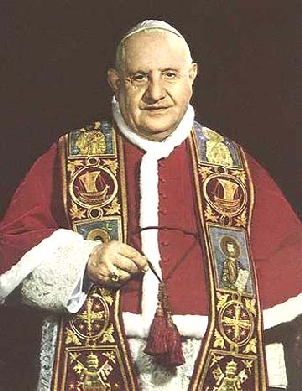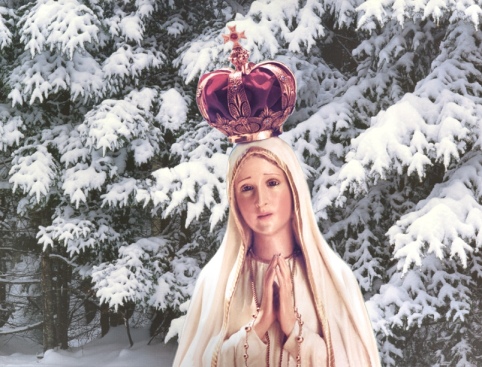Continued from Part 2of3
 The Second Vatican Council
The Second Vatican Council
(top)
Remarkably, and contrary to tradition, Vatican II refused to denounce communism:
| The Second Vatican Council, or Vatican II, was a pastoral, non-dogmatic ecumenical council of the Catholic church opened under Pope John XXIII in 1962 and closed under Pope Paul VI in 1965. That the Council was pastoral and non-dogmatic is made clear by the Opening Address of the Second Vatican Council given by Pope John XXIII on October 11, 1962. It has often been cited as the most significant event in Catholicism in the 20th century. |
| […] |
BackgroundBy the 1950s, liberal trends in Catholic theological and biblical studies had begun to move away from the neo-scholasticism and biblical literalism that the reaction to the Modernist heresy had enforced from the First Vatican Council well into the 20th century. This liberalism sprang from theologians such as Yves Congar and Karl Rahner who looked to integrate modern human experience with Christian truth, as well as others such as Joseph Ratzinger and Henri de Lubac who looked to what they saw as a more “accurate” understanding of scripture and the early Church Fathers as a source of “renewal” — in spite of Pope Gregory XVI’s Mirari Vos which warned against those ideas of “renewal.” |
| At the same time the world’s bishops faced tremendous challenges driven by political, social, economic and technical change. Many of these bishops sought changes in church structure and practice to “better” address those challenges, changes they thought long overdue. The First Vatican Council had been held nearly a century before, but had been cut short by the effects of the Franco-Prussian War. As a result, only deliberations on the role of the Papacy were completed, with examination of pastoral and dogmatic issues concerning the whole church left undone. Pope Pius XII had considered convening a Council in order to address these issues and to confront Communism, but was advised not to do so because the presence of Modernists threatened to undermine his efforts and revolutionize the Church. |
| Pope John XXIII had no such qualms, however, and gave notice of his intention to convene the Council less than three months after his election in 1959. While in many messages over the next three years he expressed his intentions in formal detail, one of the best known images is of Pope John, when asked why the Council was needed, opened a window and reportedly said “I want to throw open the windows of the Church so that we can see out and the people can see in.” In order not to offend the Orthodox in Communist countries, he consented, through the Pact of Metz, to a policy that became known as Ostpolitik, which ensured that the Council would not confront the realities of Communism. knowledgerush.com |
| A “good Pope” is a Pope who fully follows the commands of his Jesuit general. Pope John XXIII (Pope from 1958 to 1963) was such a “good Pope.” This obedience actually got him on the fast track to sainthood in the Roman Church as he is now known as “Blessed” John: |
| The General at that time was Jean-Baptiste Janssens. Under orders from his General, Pope John XXIII inaugurated the Trojan horse ecumenical movement or Vatican Council II. |
| The Latin Mass was dumped along with the dogma: there is no salvation outside the Church of Rome….All religions were now going to get you to Heaven as long as you were sincere. |
| Under the teachings of Vatican II, sincere Communists, Buddhists, Hindus, Moslems, atheists etc., etc. were all going to Heaven . . . as long as they were SINCERE!! |
| Among the multiplicity of “changes” brought about by Vatican II was the teaching that Protestants were no longer “heretics” but SEPARATED BRETHREN!! reformation.org |
In addition to the wariness of non-Catholics, not every Catholic was content with the changes brought about by Vatican II. Chief among the objections was of course its sudden abandonment of the tradition of condemning “the errors of Socialism and Communism”:
Vatican II’s Unimpeded Errors and Heresies |
“Our Lady of Fatima requested that the Pope in union with the world’s bishops consecrate Russia to the Immaculate Heart of Mary, promising Her triumph and a period of peace as the result. The Pact of Metz, otherwise known as the Vatican-Moscow Agreement has been the main obstacle to the Popes’ performing this consecration—–a consecration that would have caused the conversion of Russia and would have prevented the present scandals the Church now suffers.” Fatima – The Vatican Moscow Agreement
The Pact of Metz
| What was the matter of such great importance that was resolved at this meeting? Based on the documents that are known today, there it was established, that Communism would not be condemned by the Second Vatican Council. |
| In 1962, the Vatican and the Schismatic Russian Church came to an agreement. According to its terms, the Russian “Orthodox Church” agreed to send observers to Vatican II, under the condition that no condemnation whatsoever of Communism should be made there. [1] |
| And why were the consequences of such a pact so far-reaching and important? Because in the 20th Century a principal enemy of the Catholic Church was Communism. As such, until Vatican II, it had been condemned numerous times by the Magisterium. Moreover, in the early ’60s, a new condemnation would have been quite damaging, since Communism was passing through a serious crisis, both internally and externally. On one hand, it was losing credibility inside the USSR since the people were becoming increasingly discontent with the horrendous administrative results of 45 years of Communist demagogy. On the other hand, outside the USSR, Communism had not been able to persuade the workers and poor of free countries to take up its banner. In fact, up until that time, it had never won a free election. Therefore, the leaders of international Communism decided that it was time to begin to change the appearances of the regime in order to retain the power they had and to experiment with new methods of conquest. So in the ’60s President Nikita Khrushchev suddenly began to smile and talk about dialogue. [2] This would have been a particularly inopportune moment for the Pope or the Council to issue a formal condemnation, which could have either seriously damaged or possibly even destroyed the Communist regime. catholictradition.org |
Maybe I’m missing something here but if Communism were such a dreaded enemy of and a dire threat to the Catholic Church, then, from a Catholic perspective, how is it in any way a bad thing to see its demise?
| “News of the agreement was given in the France nouvelle, the central bulletin of the French Communist Party in the edition of January 16-22, 1963, in these terms: ‘Because the world socialist system is showing its superiority in an incontestable fashion, and is strong through the support of hundreds and hundreds of millions of men, the Church can no longer be content with a crude anti-Communism. As part of its dialogue with the Russian Orthodox Church, it has even promised there will be no direct attack on the Communist system at the Council.‘ On the Catholic side, the daily La Croix of February 15, 1963, gave notice of the agreement, concluding: “As a consequence of this conversation, Msgr. Nikodim agreed that someone should go to Moscow carrying an invitation, on condition that guarantees were given concerning the apolitical attitude of the Council.’ catholictradition.org |
When compared with the previous quote, this statement also doesn’t make sense. Here it is claimed that Communism “is showing its superiority in an incontestable fashion and is strong through the support of hundreds and hundreds of millions of men”, while in the previous quote it was claimed that it “was passing through a serious crisis, both internally and externally.” So which one is going to be? The plot thickens.
In summary, catholictradition.org states:
| 1. Catholic doctrine has always emphatically condemned Communism. It would be possible, should it be necessary, to publish a small book composed exclusively of anti-Communist pontifical documents. |
| 2. It would have been natural, therefore, for the Second Vatican Council which met in Rome from 1962 to 1965, to have confirmed these condemnations against the greatest enemy of the Church and Christian Civilization in the 20th Century. |
| 3. In addition to this, 213 Cardinals, Archbishops, and bishops solicited Paul VI to have the Council make such a condemnation. Later, 435 conciliar Fathers repeated the same request. The two petitions were duly delivered within the time limits established by the Internal Guidelines of the Council. Nonetheless, inexplicably, neither petition ever came up for debate. The first was not taken into consideration. As for the second, after the Council had closed, it was alleged that it had been “lost” by Msgr. Achille Glorieux, secretary of the commission that would have been entrusted with the request. [9] |
| 4. The Council closed without making any express censure of Communism. Why was no censure made? The matter seemed wrapped in an enigmatic fog. Only later did these significant facts on the topic appear. catholictradition.org |
Since it always has condemned “godless Communism” since its inception, what made the Catholic Church suddenly abandon this tradition?
I can think of no other reason than that Communism always had been a pet project of the Jesuits themselves (see the beginning of the first part of this appendix). Although they openly condemned Communism in the past, apparently the time had come for the Jesuits to begin to afford showing affection for their own, albeit secret, creation.
Indeed, the advent of Liberation Theology presented the Jesuits with an excuse to more openly appreciate the ideas of Marx.
Liberation Theology
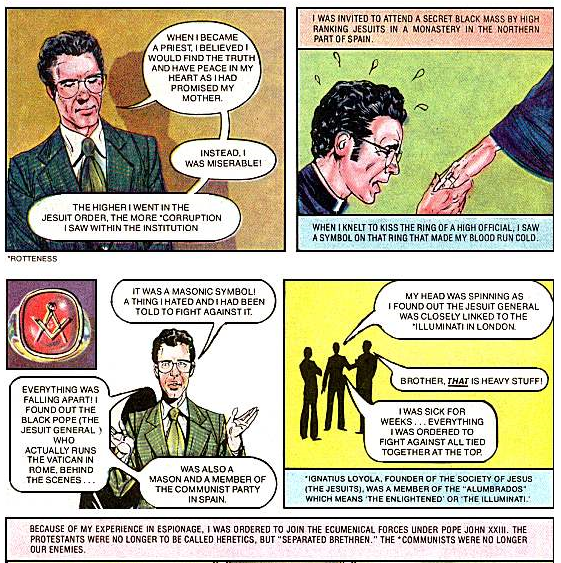
Jack Chick - "Alberto", comic book based on true story of ex-Jesuit priest Alberto Rivera blowing the whistle on his former masters. The Black Pope he mentions is Pedro Arrupe, Jesuit Superior General from to 1965 - 1983.
| After the great changes following Vatican II each bishops conference returned back to their own churches and implemented the decrees in their own particular context. The Church in Europe was threatened by a growing secularism and a scientific and materialistic atheism. The Church in Asia was conscious of its responsibilities to inter-religious dialogue and the tensions produced by the plurality of religions in their societies. The Church in South America was predominantly faced with the poverty that many considered to be caused by the perceived injustice of tiny minorities of the population owning and controlling vast amounts of the countries’ wealth and resources. Controversially the theologians in South America became more and more politically involved, often adopting Marxist positions. Many Jesuits in South and Central America, aware that the Church had in the past appeared to accept and even to defend this inequality, were at the forefront of this movement. The theology that grew out of their work was called Liberation Theology. Wikipedia (Pedro Arrupe) |
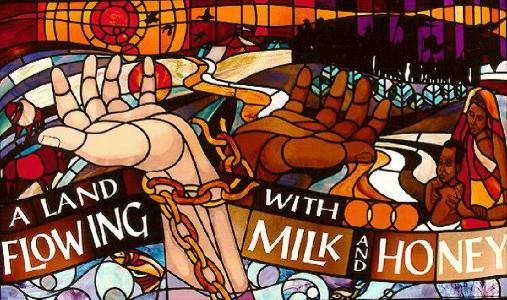
Liberation theology addresses systemic issues such as class conflict, racism, and sexism. It arose in Africa, to reject colonialism and apartheid, and in Latin America, to reject political, military, and economic oppression. In Latin America it has played a role in church and state conflicts. In 1973, the English translation of Gustavo Gutierrez's A Theology for Liberation helped spread liberation theology to North America, where it has been taken up by some African-American and feminist theologians. Major themes in liberation theology include: God's favoring of the poor and the oppressed; Jesus' identification with the poor; the imperative for Christians to act with and for the poor; biblical mandates for justice; necessity of confrontation or conflict to bring about justice.
| The Theology of Liberation is a school of Christian theology in which the salvation or liberation wrought by Christ is examined not only in terms of liberation from individual sin, but also in terms of liberation in other spheres: the aspirations of oppressed peoples and social classes; an understanding of history in which the human being is seen as assuming conscious responsibility for human destiny; and Christ the Saviour liberating the human race from sin, which is the root of all disruption of friendship and of all injustice and oppression[1]. |
| It emphasizes the Christian mission to bring justice to the poor and oppressed, particularly through political activism. Its theologians consider sin the root source of poverty, the sin in question being exploitative capitalism and class war by the rich against the poor. It has a range of meanings: broadly, especially in the media, it may refer to any politically-activist Christian thought, but the technical sense is narrower. Liberation theologians use political theory, primarily Marxism, to help understand how to combat poverty. |
| Under the name ‘theology of liberation’, it began in the Catholic Church after the Second Vatican Council, and many theologians of liberation are Roman Catholics. Some elements of certain liberation theologies have been rejected by leaders of the hierarchy of the Catholic Church over the last 30 years.[2] . It is sometimes regarded as a form of Christian socialism, and it has enjoyed widespread influence in Latin America and in the Jesuits, although its influence diminished after liberation theologians using Marxist concepts were admonished by Pope John Paul II. Wikipedia (Liberation Theology) |
 |
 |
|---|
HistoryCreated in 1955 in Rio de Janeiro (Brazil), the CELAM (Conselho Episcopal Latino Americano – Latin American Episcopal Conference) pushed the Second Vatican Council (1962-65) toward a more socially oriented stance. During the next four years, CELAM prepared for the 1968 Medellín Conference in Colombia. Cardinal Alfonso López Trujillo, who was a central figure in Medellín and who was later at the Vatican, said that the gathering of Roman Catholic bishops officially supported a version of liberation theology similar to that of the Vatican’s CDF in 1984. This began in the X Meeting of CELAM in Mar del Plata and the message Pope Paul VI issued to the Latin American Bishops, Church and Problems. Cardinal López Trujillo, in his account of those historical events, also said that the origin of liberation theology was simultaneously created by the CELAM’s Reflection Task Force, of which he was president, and a Brazilian theologian from Princeton, Rubem Alves, who in 1968 wrote Towards a Theology of Liberation. |
| […] |
| A new trend blossomed from Cardinal Joseph Ratzinger (now Pope Benedict XVI)’s and Pope John Paul II‘s condemnations of the Marxist current of liberation theology, which is called Reconciliation Theology and has had a great influence among clergy and laity in Latin America. Nonetheless, The New York Times reported on the eve of Pope Benedict’s 2007 visit to Brazil that liberation theology remains popular in Latin America, with Brazil alone the home to over one million Biblical study circles reading and interpreting the Bible from this perspective.[4] Wikipedia (Liberation Theology) |
Reaction within the Catholic ChurchThe orthodox priests who disagree with liberationism consider Liberation Theology’s world view as narrow; that it does not look at the entire meaning of God and the Bible’s writers. The orthodox accuse liberation theologians of mining the Bible in supporting their specific political and social ideology. These criticisms, in turn, provoke counter-criticisms that the orthodox, by condemning the teachings and the organization of the liberationist movement, are in effect casting their lots with authoritarian regimes. In other words, some liberationists maintain that pure doctrine is not so much what the Vatican is trying to defend, as is established ecclesiastical and political order. This conflict could be compared to some aspects of the Protestant Reformation. Outside Latin America, some of Liberation Theology’s most ardent advocates are Protestant thinkers (e.g., Jurgen Moltmann, Frederick Herzog). Wikipedia (Liberation Theology) |

Adolfo Nicolás Pachón - Superior General of the Society of Jesus, calls Liberation Theology a "courageous and creative response to an unbearable situation of injustice in Latin America."
Adolfo Nicholas and Liberation Theology
(top)
It may be interesting to note that the current Jesuit Superior General Adolfo Nicholas is remarkably fond of Liberation Theology:
Liberation theologyIn a November 2008 interview with El Periodico, Nicolás described liberation theology as a “courageous and creative response to an unbearable situation of injustice in Latin America.”[12] These remarks are particularly controversial since liberation theology has been pointedly denounced by Pope John Paul II[13] and by Pope Benedict XVI, when he was still Prefect of the Congregation for the Doctrine of the Faith.[14] However, the Superior General also added, “As with any theology, liberation theology needs years to mature. It’s a shame that it has not been given a vote of confidence and that soon its wings will be cut before it learns to fly. It needs more time.”[12] Wikipedia |
 |
 |
|---|
Catholic Vindication of Marx
(top)
Does it get even crazier? Sure it does. In October of this year (2009), the world was hit over the head by this piece of news:
| Karl Marx, who famously described religion as “the opium of the people”, has joined Galileo, Charles Darwin and Oscar Wilde on a growing list of historical figures to have undergone an unlikely reappraisal by the Roman Catholic Church.L’Osservatore Romano, the Vatican newspaper, said yesterday that Marx’s early critiques of capitalism had highlighted the “social alienation” felt by the “large part of humanity” that remained excluded, even now, from economic and political decision-making.Georg Sans, a German-born professor of the history of contemporary philosophy at the pontifical Gregorian University, wrote in an article that Marx’s work remained especially relevant today as mankind was seeking “a new harmony” between its needs and the natural environment. He also said that Marx’s theories may help to explain the enduring issue of income inequality within capitalist societies. timesonline.co.uk |
Making Sense of the Schizophrenic Relationship between the Roman Church and Communism
(top)
So to recap we first had the Jesuits perfecting Communism in Paraguayan Reductions basically by conquering and subjecting the local Guarani Indians to slavery. Then later Marx was tutored in the principles of Communism by Jesuits in the British Museum, according to Alberto Rivera. All the while the Roman Church was openly against Communism and so openly condemned it. But what the Roman Church openly condemned it secretly supported, after all Communism, had always been a Jesuit enterprise.
How did it managed to get the Russian Orthodox Church to recognize the Papacy during Vatican II? According to Avro Manhatten and ex-Jesuit Alberto Rivera they did so through infiltration of the Orthodox Church:
“In Rome and elsewhere, Catholic priests were given accelerated instruction in Russian Orthodox theology and ritual. Grandiose schemes were blueprinted for taking over the Orthodox Church, lock, stock and barrel, including the claims for her former wealth and lands; these to be put forward at a later stage, once Catholicism had taken over.” Sidney Hunter – Is Alberto for Real?
This typically Jesuitical subversive technique is also expanded upon in the next video in which not only Alberto Rivera serves to testify against the infiltration practices of the Roman Church but also quite a few other people who claim to have witnessed it first-hand in the United States:
Alberto Rivera and Others speak of Jesuit (Jesuits) Infiltration – Full Version
 |
Every major religious organization has been infiltrated and taken over by the Jesuits. They want everyone to stay in the mainstream organizations so that they can more easily be indoctrinated. Anyone outside the main churches will be more difficult to brainwash. According to Ex-Jesuit priest, Alberto Rivera, all the mainstream churches were taken over by 1980. Dr. Rivera explained that when he was under the extreme oath of the Jesuits, he was told that a secret sign was to be given to the Jesuits world-wide when the ecumenical movement had successfully wiped out protestantism, in preparation for the signing of a concordat between the Vatican and the U.S. The sign was to be when a President of the U.S. took his oath of office facing an obelisk. For the first time in U.S. history, the swearing in ceremonies were moved to the West front of the Capitol, and President Reagan faced the Washington Monument. This happened January 20, 1981. — Jack Chick, The Godfathers, Alberto Part Three, Chick Publications, page 26. Bill Hughes – The Secret Terrorists (chapter 9) |
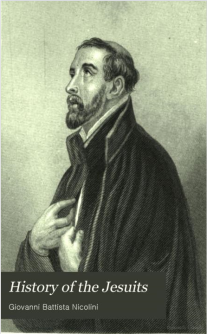 |
 |
 |
|---|
References:
- J Findlater – The Revolutionary Movement: A Diagnosis of World Disorders
- Giovanni Battista Nicolini – History of the Jesuits: their origin, progress, doctrines, and designs
- Bill Hughes – The Enemy Unmasked
- Jack T. Chick – The Godfathers
- Eric Jon Phelps – Vatican Assassins III
- Sidney Hunter – Is Alberto for Real?
